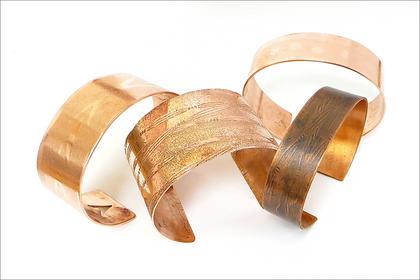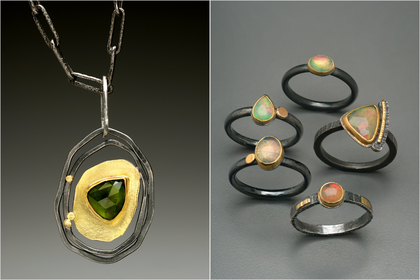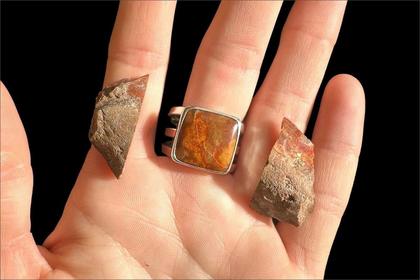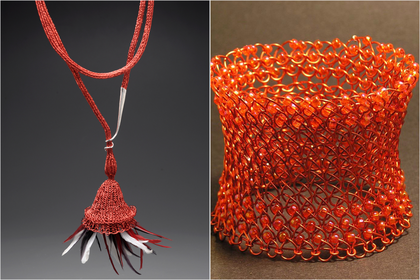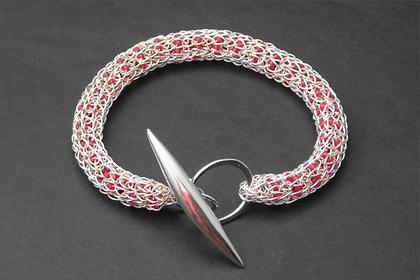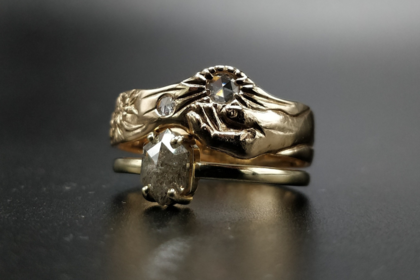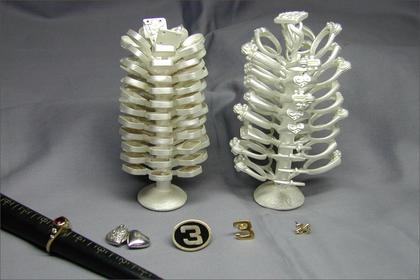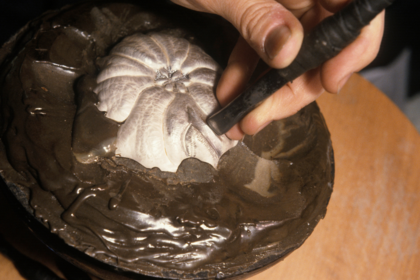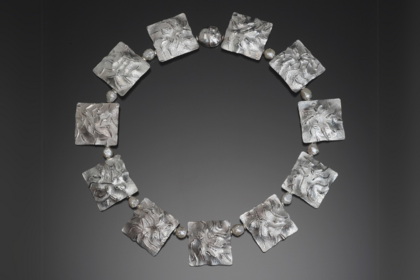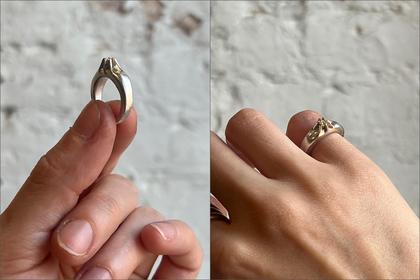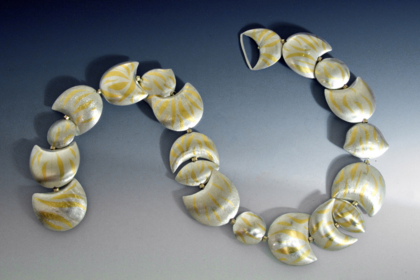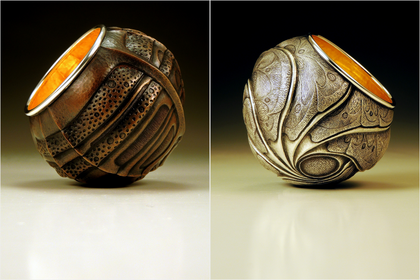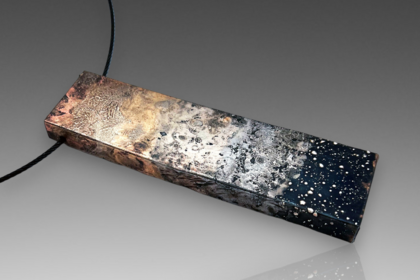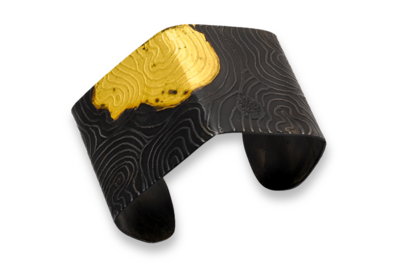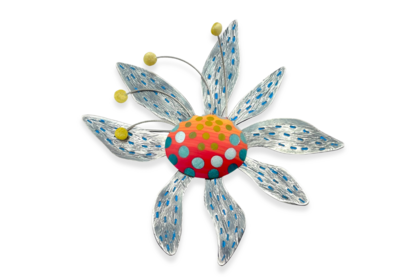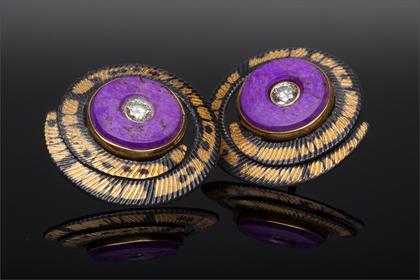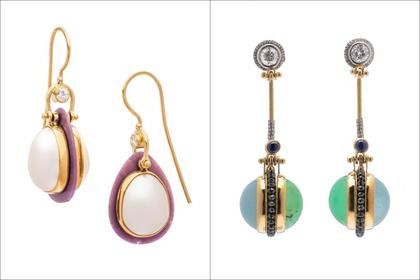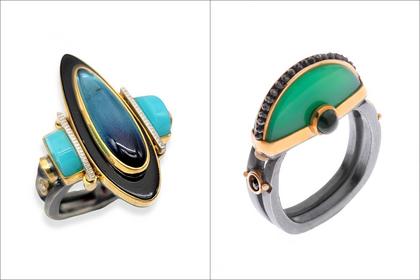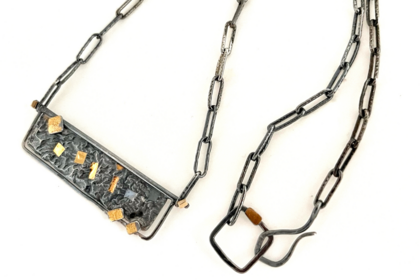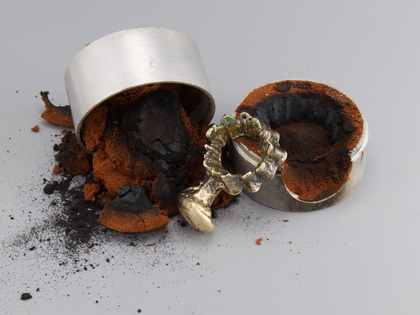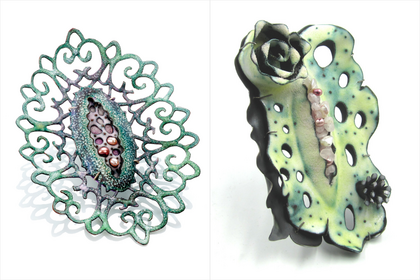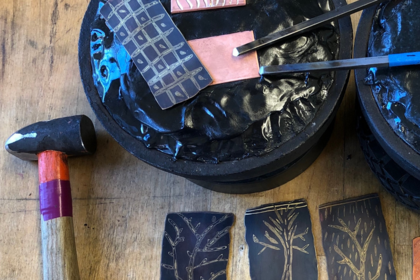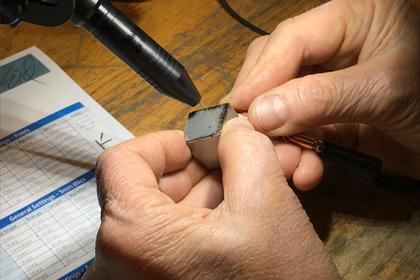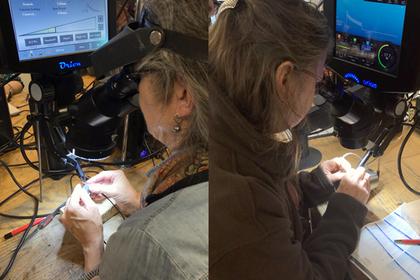Website Maintenance Alert! The Metalwerx website will be temporarily unavailable on Monday, April 28 from 12–6 PM ET. Thanks for your patience!
Onsite Courses
Workshop
With Wendy Jo New
April 25, 2025, Friday from 10:00am – 5:00pm
Tuition: $155.00
The rolling mill will be the featured piece of equipment in this 1-day workshop as you create texture for bracelets, rings, and earrings. Click on the course image to read more.
Workshop
With Paulette Werger
April 26 - 27, 2025, Saturday and Sunday
from 10:00am – 5:00pm (2 days)
Tuition: $425.00
This workshop explores methods for making bezels in gold. Students will learn different ways to construct bezels and best practices for setting stones in 22K 18K, and 14K gold. Click on class image or title for more information!
Workshop
With Allison Keast
May 9, 2025, Friday from 10:00am – 5:00pm
Tuition: $210.00
In this workshop, students will learn how to cut and shape a handmade cabochon out of a rough stone. Click on course image or title to read more.
Workshop
With Joy Raskin
May 10, 2025, Saturday from 10:00am – 5:00pm
Tuition: $210.00
Learn to make the Viking Knit chain, an ancient chain making technique which produces a tubular shape that is supple, lightweight, and beautiful to wear.
Weekly Class
With Karen Karon
May 14, 2025 - June 4, 2025, Weekly on Wednesday
from 10:00am – 1:00pm (4 days)
Tuition: $260.00
Build on your chain maille skills with weaves such as Barrel, Helm, and Half Persian 3-in-1 and variations. This class is a continuation of Foundations in Chain Maille - Session 1, open to continuing and new students. Click on course image to read more.
Workshop
With Will Vanaria (He/Him)
May 16 - 18, 2025, Friday, Saturday, and Sunday
from 10:00am – 5:00pm (3 days)
Tuition: $560.00
Learn how to create colorful, illustrative jewelry with this one* simple trick! Dive into a workshop that will combine essential silvermsithing skills with the fun colors and ease of resin inlay. (*One trick and three days of practice, of course!) Click on course image to learn more.
Workshop
With Allison Keast
May 23, 2025, Friday from 10:00am – 5:00pm
Tuition: $210.00
Join us for a one-day onsite course to unlock the super accessible yet intricate craft of a linked bracelet, with specific focus placed on the paperclip motif. Click on course image or title to read more.
Workshop
With Joy Raskin
May 24, 2025, Saturday from 10:00am – 5:00pm
, May 25, 2025, Sunday from 10:00am – 5:00pm
Tuition: $425.00
This two-day comprehensive workshop will cover the basics of box clasp, barrel clasp, hinged clasps, safety catch and toggles. We'll cover how to attach these clasps to chains, provide a refresher on riveting, and more! Click on course image to read more.
Workshop
With Hailey Pollock (She/Her)
May 30, 2025 - June 1, 2025, Friday, Saturday, and Sunday
from 10:00am – 5:00pm (3 days)
Tuition: $560.00
Explore the magic of the lost wax process for carving and casting a custom designed pendant, ring, or mini sculpture. Click on the class image or title to read more.
Workshop
With Daniel Grandi
June 6 - 8, 2025, Friday, Saturday, and Sunday
from 10:00am – 5:00pm (3 days)
Tuition: $560.00
Learn how to save time AND money by making your own molds and casting multiples with the lost wax casting technique. Learn to make molds, sprue, invest, and finish cast pieces. Click course image to read more.
Workshop
With Genevieve Montante (They/Them)
June 13 - 14, 2025, Friday and Saturday
from 10:00am – 5:00pm (2 days)
Tuition: $425.00
Learn the essentials of jewelry making and explore fundamental metalsmithing techniques by designing and creating your own gemstone ring or pendant! Click on course image or title to read more.
Summer with the Masters
With Nancy Mēgan Corwin
June 20 - 22, 2025, Friday, Saturday, and Sunday
from 10:00am – 5:00pm (3 days)
Tuition: $695.00
In this 3-day master class, learn the unique and exciting processes of chasing and repoussé from an expert. Click on course image to read more.
Summer with the Masters
With Nancy Mēgan Corwin
June 23 - 24, 2025, Monday and Tuesday
from 10:00am – 5:00pm (2 days)
Tuition: $485.00
For those with previous chasing and repoussé experience, join master artist Nancy Mēgan Corwin for a master class on chasing and repoussé with sterling silver to create organic forms, crisp effects, and dramatic textures. Click on course image to read more.
Workshop
With Genevieve Montante (They/Them)
June 28 - 29, 2025, Saturday and Sunday
from 10:00am – 5:00pm (2 days)
Tuition: $425.00
In this two-day workshop, learn to fabricate the elegant yet sturdy "buttercup" or belcher setting. Click course image or title to reach more.
Summer with the Masters
With Cynthia Eid
July 9 - 13, 2025, Wednesday, Thursday, Friday, Saturday, and Sunday
from 10:00am – 5:00pm (5 days)
Tuition: $995.00
The hydraulic press is a great tool for making both one-of-a-kind pieces and multiples. Dive into the process, art, textures, and techniques you can tap into with this unique tool with a master artist. Click on the course image to learn more.
Summer with the Masters
With David Huang
July 16 - 20, 2025, Wednesday, Thursday, Friday, Saturday, and Sunday
from 10:00am – 5:00pm (5 days)
Tuition: $995.00
Combine the traditional processes of angle raising with hammer chasing to create vessels embellished with design and texture with artist David Huang. Click on course image to read more.
Summer with the Masters
With Bette Barnett
July 23 - 24, 2025, Wednesday and Thursday
from 10:00am – 5:00pm (2 days)
Tuition: $485.00
An innovative two-day master class where you’ll explore a new, groundbreaking metal fusing technique, painting powdered metals on steel, and experiment with color, texture, and pattern. Click on course image to learn more.
Summer with the Masters
With Bette Barnett
July 25 - 27, 2025, Friday, Saturday, and Sunday
from 10:00am – 5:00pm (3 days)
Tuition: $695.00
It’s time to ditch the uninspired and create intense drama by etching steel in nonconventional ways and then adding a layer of shine with Keum-boo and Eun-boo! Click on course image to learn more.
Summer with the Masters
With Bonnie Bishoff
July 30, 2025 - August 3, 2025, Wednesday, Thursday, Friday, Saturday, and Sunday
from 10:00am – 5:00pm (5 days)
Tuition: $995.00
The possibilities are endless for form and design when you combine polymer clay with sheet metal and wire. Don't miss this rare chance to learn from polymer artist Bonnie Bishoff in person! Click on course image to learn more.
Summer with the Masters
With Michael Boyd
August 5 - 6, 2025, Tuesday and Wednesday
from 10:00am – 5:00pm (2 days)
Tuition: $485.00
This 2-day master class will incorporate Michael Boyd's technique for fusing gold patterns onto Argentium silver for brilliant patterns and designs! Click on course image to read more.
Summer with the Masters
With Michael Boyd
August 8 - 10, 2025, Friday, Saturday, and Sunday
from 10:00am – 5:00pm (3 days)
Tuition: $695.00
Spend three days with Michael Boyd and learn how to cut and polish your own cabochons with limitless shape, size, and color options. Click on course image to read more.
Summer with the Masters
With Michael Boyd
August 13 - 17, 2025, Wednesday, Thursday, Friday, Saturday, and Sunday
from 10:00am – 5:00pm (5 days)
Tuition: $995.00
Learn how to integrate stone and metal as a whole, rather than as separate objects, from shaping rough stones, making custom bezels, setting stones on top of stones, adding decorative rivets, and more. Click on course image to read more.
Summer with the Masters
With Paulette Werger
August 20 - 24, 2025, Wednesday, Thursday, Friday, Saturday, and Sunday
from 10:00am – 5:00pm (5 days)
Tuition: $995.00
This class is designed to take an in-depth look at combining the Korean technique of Keum-boo with the silver textured peaks and valleys created with reticulation. Click on course image to read more.
Workshop
With Will Vanaria (He/Him)
September 5 - 6, 2025, Friday and Saturday
from 10:00am – 5:00pm (2 days)
Tuition: $425.00
Learn how to cast metal using the ancient technique of sand casting! Click on the course image or title for more information.
Summer with the Masters
With Michael Good
September 10 - 14, 2025, Wednesday, Thursday, Friday, Saturday, and Sunday
from 10:00am – 5:00pm (5 days)
Tuition: $995.00
Metalsmithing master Michael Good will lead students through a series of exercises designed to teach the principles of Anticlastic Raising - moving metal from flat sheet into complex curved forms. Click on course image or title to read more.
Summer with the Masters
With Kathryn Osgood
September 17 - 21, 2025, Wednesday, Thursday, Friday, Saturday, and Sunday
from 10:00am – 5:00pm (5 days)
Tuition: $995.00
Add dimension and color to your work with the unique combination of silhouette dies, forming, texturing, vitreous enamels, and more. Click on course image to read more.
Summer with the Masters
With Anne Wolf
September 25 - 27, 2025, Thursday, Friday, and Saturday
from 10:00am – 5:00pm (3 days)
Tuition: $695.00
Mokume Gane is an ancient Japanese technique that uses fused layers of different metals to form unique organic patterns. Create multiple samples or finished work as you dive into chisel patterning, the most most traditional way of patterning mokume gane. Click on course image to read more.
Workshop
With Wendy Jo New
December 31, 2025, Wednesday from 10:00am – 4:00pm
Tuition: $425.00
Tuition covers 6 hours of instruction and practice time with Wendy Jo New. These dates and times are flexible and can be adjusted directly with the instructor after registration has been completed. Please contact us at [email protected] if you have any questions. Click the image for more details!
Workshop
With David Baird
December 31, 2025, Wednesday from 11:00am – 5:00pm
Tuition: $425.00
Tuition covers 6 hours of instruction and practice time with David Baird. These dates and times are flexible and can be adjusted directly with the instructor after registration has been completed. Please contact us at [email protected] if you have any questions. Click the image for more details!

